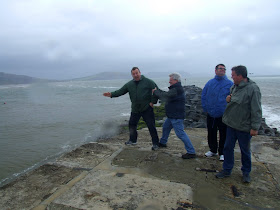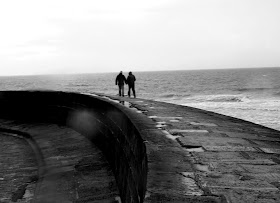
Steventon Church, where Jane's father the Reverend Austen was the vicar. Jane was christened here and attended services every week.

This is rather an intriguing sign. It is the sign outside the church in Farringdon."NORTHANGER BENEFICE," no less.

Chawton Parish Church.
St Nicholas.

The main church in Alton.
Alton was the local town to Chawton and Jane often went here shopping. She would have known this church.

A print showing Southampton High Street in the 18th century. All Saints, Dr Mant's church, is the Greek porticoed building on the left.

I'm not sure Jane would approve but I'm sure some of her vicar characters would not be averse to some ,"rumpy pumpy," don't you think.
The new Vicar was up early one Sunday morning, walking around his new parish, after leaving his wife in bed with the Sunday papers, her cup of tea, and a pack of cigarettes.One of the old villagers came up to him and said. “Good morning, Vicar, how be you and the wife?”
The Vicar said, “Good morning my man, I am fine, the wife is fine also. I left her in bed smoking.”
The villager said, “Arr, Vicar, that’s the way to fuck ‘em!”
The new Vicar was up early one Sunday morning, walking around his new parish, after leaving his wife in bed with the Sunday papers, her cup of tea, and a pack of cigarettes.One of the old villagers came up to him and said. “Good morning, Vicar, how be you and the wife?”
The Vicar said, “Good morning my man, I am fine, the wife is fine also. I left her in bed smoking.”
The villager said, “Arr, Vicar, that’s the way to fuck ‘em!”
(Mr and Mrs Norris from Mansfield Park, when they first moved into the living of Mansfield? Perhaps not! )
Jane Austen's relationship with vicars was an integral part of her own life, her father and two of her brothers, James and Henry were vicars. Henry became a curate in various parishes after his bank failed. Many of the most prominent and sometimes important characters in her novels are vicars. Mr Elton in Emma, and Mr Norris, who we never meet and Edward Bertram in Mansfield Park are amongst them.
Jane Austen's relationship with vicars was an integral part of her own life, her father and two of her brothers, James and Henry were vicars. Henry became a curate in various parishes after his bank failed. Many of the most prominent and sometimes important characters in her novels are vicars. Mr Elton in Emma, and Mr Norris, who we never meet and Edward Bertram in Mansfield Park are amongst them.
Being a vicar in the 18th century was a lower middle class occupation. Vicars and vicars wives and families were a specific strata of society. It was considered a way of making a living with property and income attached.
When Emma is discussing with Harriet the suitability of Mr Elliot as a suitor, her considerations are,
" He had a comfortable home for her, and Emma imagined a very sufficient income; for though the vicarage at Highbury as not large, he was known to have some independent property;......"
In Mansfield Park, Mr Norris, never appears, he is merely spoken of by his wife. His character seems to be a foil by which the personality and character of Mrs Norris is accentuated even more sharply.He dies early in the novel . When he is dead Mrs Norris,
"consoled herself for the loss of her husband by considering that she could do very well without him..."
That seems to be a chilling comment. For a person to be unloved and not cared for to that extent by somebody who purports to love them, is quite horrific. Mrs Norris shows her total self interest to a degree, with that statement. Mr Norris may well have been the sort of vicar who only cared about house and income but he doesn't deserve that level of indifference from his wife.
Edmund Bertram, on the other hand, is different. If a definition of a good christian is to judge them by their actions not just their speech, then Edmund portrays what a good christian and vicar should be.
Edmund's thoughtfulness towards Fanny and the quick actions he takes to make her comfortable and the care he shows her are all traits which make him material for a truly christian vicar.
When Fanny is pining after her brother and childhood playmate,William, Edmund, immediately supplies her with writing materials and sees that Fanny's letter is franked and posted.
" If that be all your difficulty, I will furnish you with paper and every other material, and you may write your letter whenever you choose."
Edmund puts himself out considerably for Fanny when he exchanges one of his own three horses for a horse more suitable for Fanny to ride, so she may get exercise.Nothing is too much for him.
Edmund requires a home and some income though. His father is acutely aware of this,when Tom, the elder, reprobate, brother, has squandered a proportion of his fathers wealth on betting and gambling and Sir Thomas is then unable to offer Edmund the living of Mansfield immediately after Mr Norris's death.
" you have robbed Edmund for ten, twenty, thirty years, perhaps for life."
We all need to have food and shelter and clothing on our backs.
The passage in Mansfield Park that really sets out the difference between the materially interested vicar and the true Christian is the discussion between Mary Crawford and Edmund when Miss Crawford finds out that Edmund is to become a vicar. You can immediately see the change in attitude Mary has to Edmund from that moment onwards.
Edmund relates a sort of manifesto about what he thinks a clergyman should be and should not be,
"A clergyman cannot be in a high state or fashion. he must not head mobs, or set the tone in dress. But I cannot call that situation nothing, which has the charge of all that is of the first importance to mankind, individually or collectively considered temporally or eternally- which was the guardianship of religion and morals and consequently from the manners which result from their influence."
Edmund himself is a great example of ,"the manners which result."
Jane throughout her life had first hand knowledge of clergymen. Her father and brothers amongst many. She knew what was good and bad about the profession. She had real life examples to provide her with evidence.
In some of her letters written while living in Castle Square, Southampton, she mentions, Dr Mant, who was the rector of All Souls, a church in Southampton High Street near The Bargate.
Dr Mant had been an Oxford Fellow like her own father, George Austen. Dr Mant was a super star in the firmament of the clergy, having written influential books and pamphlets about theology. He was also a charismatic preacher and Jane often mentions listening to his sermons. He also had been the headmaster of King Edwards Grammar School in Southampton for a number of years. However, Jane suggests a salacious side to him. How much a slightly cruel joke, pointed at her best friend Martha Lloyd, or how much truth there is behind it, it is impossible to ascertain. Jane relates how Mrs Mant left Southampton with her children for a while to get away from the attention her husband, religious super star, that he was, seemed to be attracting.
To Cassandra Austen Tuesday 17th January 1809 from Castle Square,
"Martha & Dr Mant are as bad as ever;he runs after her in the street to apologise for having spoken to a gentleman, while she was near him the day before.- Poor Mrs Mant can stand it no longer; she is retired to one of her married daughters."
Dr Mant was obviously a clergyman on a steep successful career slope. But fine words and sermons don't make Dr Mant, Edmund Bertram's idea of a true vicar. Dr Mant had been a headmaster and given some of his life to educating children which is a giving profession and requires the understanding and development of others. But which sort of vicar was he truly, an Edmund or a Mr Elliot. We cannot tell. He had a very interested following though.
I am sure Jane got her understanding of what a good clergyman is from the experience of her own father and brothers, but did they also provide some of the attributes of Mr Norris and Mr Elliot?
After all, George Austen, Jane's father, retired as vicar of Steventon and moved to Bath. Bath, the 18th century equivalent of Blackpool or Coney Island.















 Putting flags up in their garden to celebrate.
Putting flags up in their garden to celebrate.














